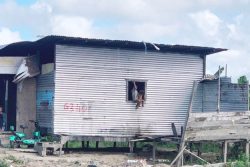Dear Editor,
The government’s plans to encourage economic growth through direct taxpayer investment in infrastructure are unconvincing, and will lead to higher costs for consumers and bigger financial burdens on the taxpayers. The Public Sector Investment Programme (PSIP) is simply a long list of projects requiring huge amounts of money, not a real plan with a strategic vision and a clear understanding of the nation’s competitive advantages as compared to the National Development Strategy. The completion of the MMA Phase II and III should have definitely found a place on that list as priority projects if the planners were thinking about Guyana strategically.
Why isn’t the international private sector better incentivized to take a greater stake in the spending on some of these PSIP projects? Why can’t we model the Cheddi Jagan Airport as a publicly listed company to tap into new streams of resources rather than continue to follow this flawed model of overburdening the taxpayers?
DDL and Banks DIH just announced they will be investing over a billion dollars each in their operations, and one must be convinced that these companies and many others including foreigners will invest in a publicly listed company that owns and manages the airport. The government may want to maintain 51% of the shares for national security reasons but private management of the airport is more optimal.
In Guyana taxpayers are already badly squeezed with all the different kinds of taxes and to be further burdened by another $31 billion in new debt for an expansion of the airport is just too financially demanding. Inevitably those with the lowest incomes will be hit hardest.
What would be most useful for Guyana is an extension of the main runway to 10,500 ft, but that is not expected to cost more than $12 billion and there is certainly enough new income expected from the new airlines to justify this extension, but not a new terminal.
Government cannot continue to operate as if it has echopraxia by imitating what it observes others doing; it has to think of unique solutions. Government has to be more creative at raising private funds for mega-projects, and no one with any care for the taxpayers would be against using taxpayers’ money to attract investors through direct grants, guaranteed incomes or agreeing to bear certain risks. However, taking 100% of the financial burden and risk is an ill thought-out option that is driven by non-commercial reasons. Once a project demands even 1% of taxpayer resources, full transparency is essential; that should be the new normal in Guyana. Therefore there is no option apart from commissioning an economic feasibility study and having that and the full contract in the public domain; after all you cannot want to spend taxpayers’ money and not seek their permission.
These concerns about the ongoing lack of visibility around a pipeline of infrastructure work are also being voiced by civil society, resulting in the Parliament taking a few of them out of the 2013 Budget for reasons of lack of transparency; an act that is quite reasonable and justifiable. Full transparency must be flourishing in respect of these projects.
As a final word, I want to emphasis the criticality of public-private projects and welcome the proposal in relation to another mega-project, the Amailas Fall Hydro project. However, once one cent of the taxpayers’ resources is used, full transparency is the order of the day. We cannot have the state pumping $16 billion into this project and the Parliamentarians excluded from interrogating these contracts, even if they are sworn to a confidentiality oath. So as Moses Nagamootoo demanded, let us await the due diligence report on the Amaila Hydro project from the Inter-American Development Bank; quite mature and sound advice.
At the end of the day any new debt burden on the children of Guyana must pass the test of economic feasibility including a practical payback plan, an analysis of the impact on the economy, an outline of the new permanent employment created as a result of these works, and an understanding of the new income streams, among others. The government’s plans to encourage economic growth through this airport expansion project remain unconvincing; let us extend the main runway only for now – we can afford $12 billion, not $31 billion.
Yours faithfully,
Sasenarine Singh





